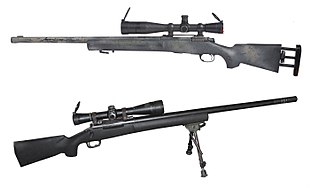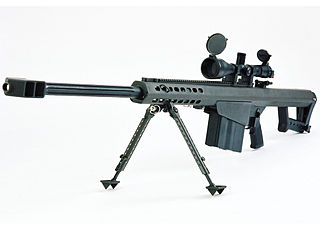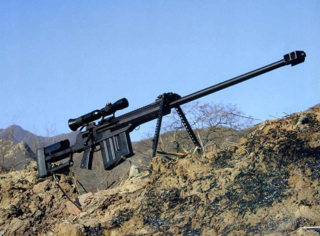
The .50 BMG, also known as 12.7×99mm NATO, and designated as the 50 Browning by the C.I.P., is a .50 in (12.7 mm) caliber cartridge developed for the M2 Browning heavy machine gun in the late 1910s, entering official service in 1921. Under STANAG 4383, it is a standard service cartridge for NATO forces, as well as many non-NATO countries. The cartridge itself has been made in many variants: multiple generations of regular ball, tracer, armor-piercing (AP), incendiary, and saboted sub-caliber rounds. The rounds intended for machine guns are made into a continuous ammunition belt using metallic links.

A sniper rifle is a high-precision, long-range rifle. Requirements include high accuracy, reliability, and mobility, concealment, and optics, for anti-personnel, anti-materiel and surveillance uses by military snipers. The modern sniper rifle is a portable shoulder-fired rifle with either a bolt action or semi-automatic action, fitted with a telescopic sight for extreme accuracy and chambered for a high-ballistic performance centerfire cartridge.

An anti-materiel rifle (AMR) is a rifle designed for use against military equipment, structures, and other hardware (materiel) targets. Anti-materiel rifles are chambered in significantly larger calibers than conventional rifles and are employed to eliminate equipment such as engines and unarmored or lightly armored targets. While modern armored vehicles are resistant to anti-materiel rifles, the extended range and penetration still has many modern applications. While not intended for use against human targets, the bullet weight and velocity of anti-materiel rifles gives them exceptional long-range capability even when compared with designated sniper rifles. Anti-materiel rifles are made in both bolt-action as well as semi-automatic designs.

The .338 Lapua Magnum is a rimless, bottlenecked, centerfire rifle cartridge. It was developed during the 1980s as a high-powered, long-range cartridge for military snipers. Due to its use in the War in Afghanistan and the Iraq War, the cartridge has become widely available.

The NTW-20 is a South African anti-materiel rifle, developed by Denel Mechem in the 1990s. It is intended for deployment against targets including parked aircraft, telecommunication masts, power lines, missile sites, radar installations, refineries, satellite dishes, gun emplacements, bunkers, and personnel, using a range of specialised projectiles. As with other weapons of this type, it can also be used for counter sniping and ordnance disposal.

The Barrett M82 is a recoil-operated, semi-automatic anti-materiel rifle developed by the American company Barrett Firearms Manufacturing.

The KSVK 12.7 or Degtyarev sniper rifle is a 12.7mm anti-materiel rifle developed in Russia for the purpose of counter sniping and penetrating thick walls, as well as light armored vehicles.

The 14.5×114mm is a heavy machine gun and anti-materiel rifle cartridge used by the Soviet Union, the former Warsaw Pact, modern Russia, and other countries.

The Steyr HS .50 and the Steyr HS .460 are single-shot anti-materiel rifles manufactured by Steyr Mannlicher and chambered in .50 BMG and .460 Steyr, respectively. Unlicensed variants of the HS. 50 include the AM-50 Sayyad produced by Iran and the Golan S-01 produced by Syria.

The RT-20 is a Croatian bullpup anti-materiel rifle developed by Metallic in Rijeka in the mid-1990s and marketed by RH-Alan. It was developed to shoot the thermal sights on Serbian M-84 and T-72 tanks. The name itself is an acronym of the Croatian word Ručni Top 20, or "Hand Cannon 20mm". Operating with a bolt action, it houses a single 20mm round and must be reloaded after each shot. Given its large caliber, it is one of the most powerful anti-materiel rifles currently in use by any country and is comparable to the South African Denel NTW-20 and the Indian Vidhwansak, with the difference being that the RT-20 is recoilless.
The Gepárd anti-materiel rifles are a family of Hungarian weapons manufactured by Sero International designed to destroy unarmored and lightly armored targets. These long-range large-caliber rifles have high accuracy and muzzle velocity. In 1987, the Hungarian People's Army sought to obtain a compact, mobile weapon that could damage lightly armored targets. The project, led by Ferenc Földi, culminated in the creation of the Gepárds.

The Mechanical and Chemical Industry Corporation, established in 1950, is a reorganization of government-controlled group of factories in Turkey that supplied the Turkish Armed Forces with military products.

The AMR-2 is a 12.7mm sniper rifle which was developed in China as an anti-materiel sniper weapon, it was introduced in the early 2000s. Designed and developed by Sichuan Huaqing Machinery Co. Ltd, a subsidiary of China South Industries Group, the rifle uses a conventional bolt-action design. The AMR-2 fires a 12.7×108mm cartridge from a 5-round box detachable box magazine fitted directly ahead of the trigger group. The barrel is free-floating and has a large double baffle muzzle brake to mitigate recoil.

The T93 Sniper Rifle is a 7.62×51mm bolt-action rifle designed and manufactured in Taiwan.
The Barrett Model 98B was a bolt-action sniper rifle chambered in .338 Lapua Magnum and manufactured by Barrett Firearms Manufacturing. The Model 98B was officially announced in October 2008, and became available for sale in early 2009, with an MSRP of $4,495.00.
The Howa 1500 or Howa M1500 is a bolt-action rifle produced in Japan by Howa Machinery. Introduced in 1979, it has been used by hunters as a hunting rifle with various cartridge offerings. It is also utilized by military and law enforcement elements as a sniper rifle. It is sold under the name of Howa Model 1500 Rifle for overseas markets.

The Anzio 20mm rifle is an American anti-materiel rifle designed and marketed by Anzio Iron Works. It is the first American anti-materiel rifle designed and mass-produced for public sale with a bore diameter in excess of .50 caliber in over 80 years. The rifles are available in three calibers, with the rifle's predominant chambering being the 20mm Vulcan caliber.

Ordnance Factory Tiruchirappalli (OFT), also called Ordnance Factory Trichy, is a small arms factory operated by Advanced Weapons and Equipment India Limited based in Tiruchirappalli, Tamil Nadu, which was previously part of Ordnance Factory Board of the Ministry of Defence, Government of India. The company is headed only by an IOFS officer called General Manager (ex officio Additional Secretary to Government of India) who is the chief executive officer, responsible for the overall management of the company.

Arash is an Iranian 20mm semi-automatic anti-materiel sniper rifle. This weapon is used by Iran and Hezbollah, and is named for the mythical Arash the Archer.
The Azb DMR MK1 or Azb MK1 is a Pakistani light weight semi-automatic designated marksman rifle designed and manufactured by the POF. It was first unveiled at the December 2014 IDEAS exhibition. It is believed to be named after the Counter-terrorist operation in North-West Pakistan Operation Zarb-e-Azb which had just been commenced at the time the Sniper rifle was introduced. It itself was designed for the Low intensity operations that were occurring during its time. The rifle has taken part in many international defence exhibitions and has been offered for export.
















